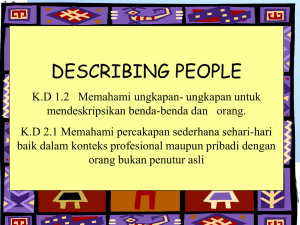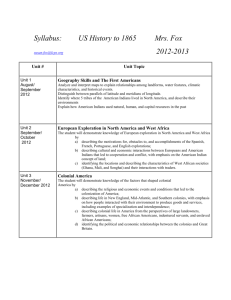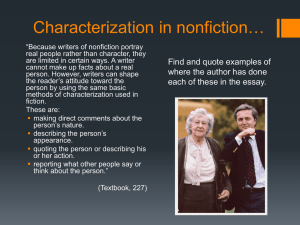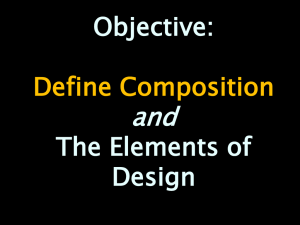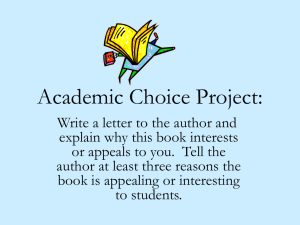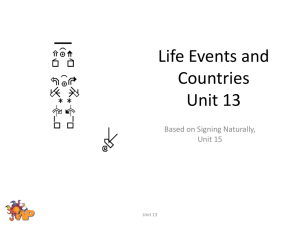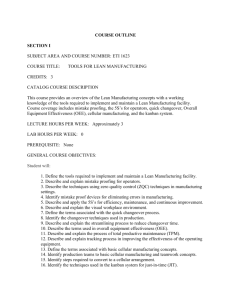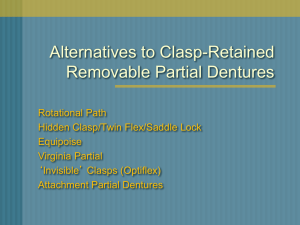Describing Complex Objects & Food PowerPoint
advertisement
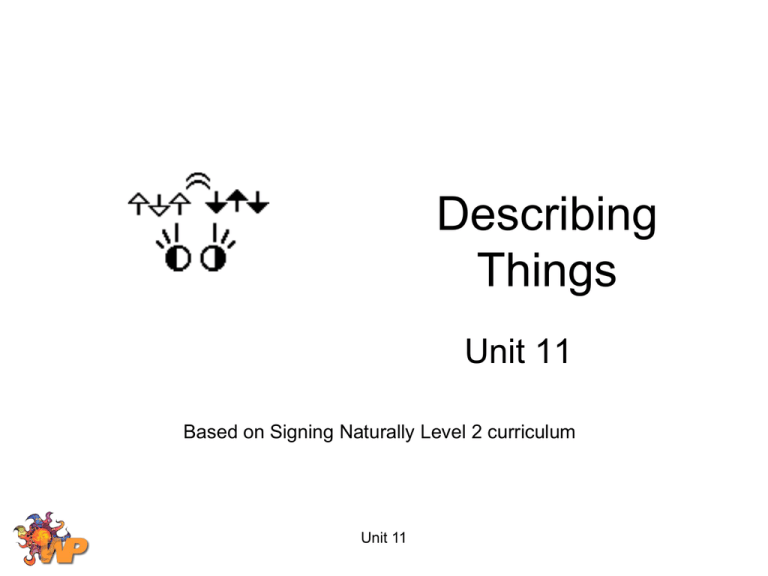
Describing Things Unit 11 Based on Signing Naturally Level 2 curriculum Unit 11 Numbering Types Review 1. Cardinal – Counting 2. Ordinal – Order 3. Address, phone & other listed numbers 4. Clock time, seconds, minutes, hours, days, weeks, months, years - past and future 5. Age 6. Date - Year 7. Money 8. Height 1. 2. 3. 4. 5. 6. 7. 8. Unit 11 1-5, palm faces inward Number twists forward and outward slightly (Rule of 9). 10 & up spell “th” after number. All numbers face forward Combines with each type of time sign (Rule of 9) Starts from the age spot on chin Month abbreviations & centuryyear combo (2000-2009 exception) Cents spot on forehead & dollar twist (Rule of 9) Moves upward, feet to inches Number Types Review Practice: MASL Blue Book, p. 120 - 124 5 minutes 5’4” 20 days 22nd $254.00 Two years ago 6 hours 4 weeks 40 years old Next year 8 months November 11th, 2011 5 days 3 years old 79 cents Three days ago 4th 8219 E. Speedway (520) 225-1906 Unit 11 How much does each job pay? Unit 10 11 Describing Surface Patterns Unit 11 Various Patterns on Objects Unit 11 More Patterns on Objects Unit 11 Describing Surface Shapes and Textures Unit 11 Bumpy, Wavy, Ridges Unit 11 Shiny, Sparkly Unit 11 Fuzzy, Downy, Woolly Unit 11 Soft, Squishy Unit 11 Solid, Firm, Hard Unit 11 Materials That Things Are Made Of Unit 11 Wood Unit 11 Metal Unit 11 Plastic Unit 11 Rubber Unit 11 Glass Unit 11 Cloth, Material Unit 11 Paper Unit 11 General Sequence for Describing “Unfixed” Objects – Things that are portable and unattached to any surface such as accessories, small appliances & food items The amount and kind of information you give in describing an object depends on the purpose of your description. It also depends on how familiar your listener is with the object you describe. Your purpose and/or emphasis will affect the sequence you use, but in general, follow this sequece to describe how something looks: 1. Name of object / material 2. Color or relevant parts 3. Basic shape and size, using NMS 4. Hold basic shape as reference point – describe designs, features or attachments 5. Show how to use or handle object, if relevant Unit 11 General Sequence for Describing “Fixed” Objects – Things that are attached to the floor or ceiling, or are not normally moved around The basic sequence is the same as for and unfixed object, but will vary according to the following categories of objects: 1. Columnar things that stand upright from the ground – describe bottom to top (floor lamp, pole, tree, fire hydrant…) 2. Large, bulky objects on the ground – describe basic shape top to bottom, then add details (fridge, dresser, stove, mountain…) 3. Columnar things that hang from the ceiling, describe from ceiling down (ceiling fan, chandelier, mobile, icicles, stalactite) 4. Objects that are an unusual size or shape, or are too large to describe in their actual dimensions are abstracted into a smaller size (sofa, rocking chair, sports car…) Unit 11 Determining Proper Perspectives for Description 1. Describe from front: Object has a definite front and back (TV, computer, radio, blender, dresser, sofa…) 2. Describe in neutral space: Object has no definite front or back (dining table, coffee table, toaster, pots & pans, basket, plant, lamp…) 3. Describe from rear: If object is usually used from the rear, show how it is handled (camcorder, binoculars, camera, microphone…) 4. Describe from a sitting position: If object is usually seen from a sitting position, describe attachments (foot rest on recliner, arm rests, controls on a car, bike or motorcycle…) 5. Describe on you body: If the object is used on a person’s body, describe as if you were wearing it (clothes, glasses, cap, gloves…) Unit 11 The Science Lab Signing Naturally Level 2, Unit 16 Observe how the scientist contrasts sizes and distinctive features to clarify which object she means. Also observe how she uses her weak hand as a reference point. Unit 11 Describing Objects, SN2 video – p. 1 Watch the examples, then fill in the blanks according to the descriptions signed on the video • • Example 1. Object: 2. Material: 3. Basic shape: 4. Details: 5. Perspective: 6. Sequence (fixed or not, top to bottom or bottom to top): 1. Example 1. Object: 2. Material: 3. Basic shape: 4. Details: 5. Perspective: 6. Sequence (fixed or not, top to bottom or bottom to top): 2. Unit 11 1. 2. 3. 4. 5. 6. Object: Material: Basic shape: Details: Perspective: Sequence (fixed or not, top to bottom or bottom to top): 1. 2. 3. 4. 5. 6. Object: Material: Basic shape: Details: Perspective: Sequence (fixed or not, top to bottom or bottom to top): Describing Objects, SN2 video – p. 2 Watch the examples, then fill in the blanks according to the descriptions signed on the video 3. 5. 1. 2. 3. 4. 5. 6. Object: Material: Basic shape: Details: Perspective: Sequence (fixed or not, top to bottom or bottom to top): 1. 2. 3. 4. 5. 6. Object: Material: Basic shape: Details: Perspective: Sequence (fixed or not, top to bottom or bottom to top): 1. 2. 3. 4. 5. 6. 4. Unit 11 Object: Material: Basic shape: Details: Perspective: Sequence (fixed or not, top to bottom or bottom to top): Unit 11 Basic Shapes Describe the shapes exactly as you see them in the pictures to the right. Unit 11 Symmetrical Objects: Add Attachments Describe each basic shape in the left column, then change the description 6 times for each by adding various attachments from the right column. Unit 11 Asymmetrical combinations Sign various base shapes with attachments. Can your partner find the shape you sign? Remember, hold your weak hand in the base shape as a reference point. You can sign either left or right handed, depending on where the attachment is. 1 A B C D E F Unit 11 2 3 4 5 Press Pull & Open Describe how objects and their attachments work. Unit 11 How Does It Work? Describe and item by showing how it works Unit 11 “New Names, Old Objects” As each word on the board is defined, find the corresponding picture and write the word below it. Unit 11 “New Names, Old Objects” Activity Key Unit 11 “Names of Things You Might Not Know” As each word on the board is introduced, find the corresponding picture and write the word below it. Unit 11 “Names Things You Might Not Know” Activity Key Unit 11 “The Store” Game • Store Owners: – Do not show your paper to customers. – Customers must describe an item they need to you. If you have it, sign the price to the customer. • Customers: – Do not show your pictures to the store owners – Describe an item in sign and ask if a store owner has it. If they have it, ask the price. – Write the price on a separate sheet of paper & the store # where you got it. Unit 11 Store 1 Unit 11 Store 2 Unit 11 Store 3 Unit 11 Store 4 Unit 11 1. 2. 3. 4. 5. 6. 7. 8. 9. Picture It Several signers will each describe an object. Visualize the object as they describe it. After each description, stop the tape and draw the object as accurately as possible. Unit 11 Unit 11 Food Preparation Unit 11 Cook, fry Unit 11 Pour Unit 11 Roll Unit 11 Cut, Slice Unit 11 Chop, Cube, Dice Unit 11 Boil Unit 11 Grate Unit 11 Spread Unit 11 Mash Unit 11 Stir Unit 11 Mix Unit 11 Shake on top of Sprinkle on top of Unit 11 Spoon-in Unit 11 Bake Unit 11 Describing how food is made – Watch Signing Naturally Level 2 Unit 16: • Potpourri – Mindialogue 4 • What’s a Sashimi? Unit 11 Describe a food you know how to make to a partner Unit 11 Opinions of Food Unit 11 Delicious or Disgusting? Delicious So-so Awful Strange Disgusting Yuck! Ok Unit 11 Would you eat it? Describe the food and tell your opinion of it. Unit 11 Flavors Unit 11 Sour, Bitter Unit 11 Salty Unit 11 Sweet Unit 11 Greasy Unit 11 Spicy-hot Unit 11 With a partner or group, sign as many foods as you can for each flavor Describing a Complex Object or Recipe Rubric Name: 2 3 4 3 or more elements missing 2 elements missing 1 element missing All elements present Non Manual Signals Few or no NMS Some correct NMS Many correct NMS NMS present throughout with correct timing Sign Production (HOLM) 3 or more incorrect signs 2 incorrect signs 1 incorrect sign All signs produced correctly Very halting, many unnatural pauses Somewhat halting, several unnatural pauses Mostly smooth, little hesitancy No hesitancy, very smooth -Each object must have at least 4 parts or steps described -Object descriptions follow rules for descriptions -Recipes also describe colors, flavors and temperatures of food as it should be served. -Includes Classifiers Fluency / Smoothness of signing Unit 11 5

